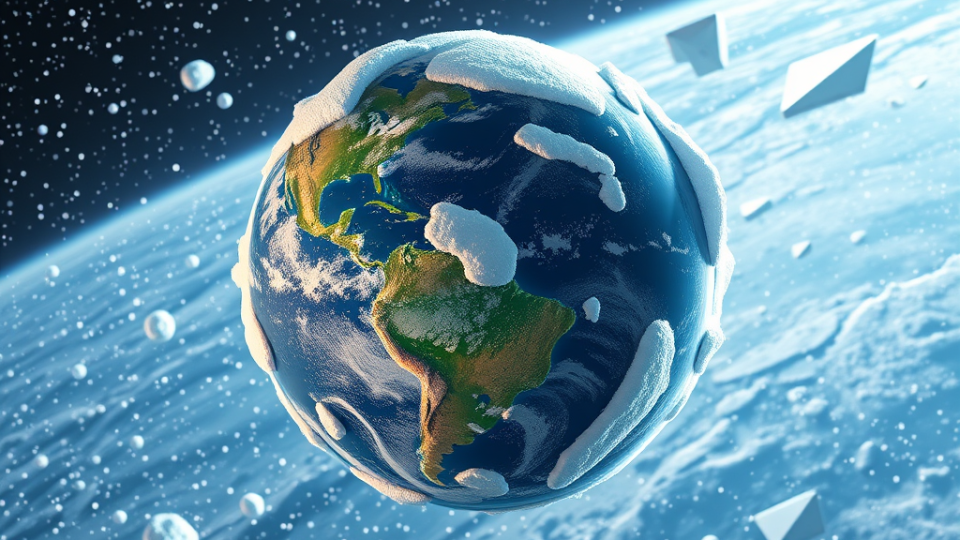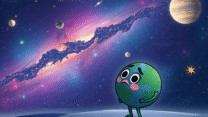
The Hitchhiker’s Guide to Snow
Snow is a meteorological phenomenon occurring on Earth and approximately 4,872 other documented planets in the galaxy, though it should be noted that Earth’s version is particularly quaint in both its composition and the baffling behavioral changes it induces in the local population.
What Is Snow (Earth Variant)?
On Earth, snow consists of frozen water crystals that fall from the sky when atmospheric conditions reach approximately 0°C (32°F for Americans, who maintain a measurement system based apparently on the body temperature of horses). These crystals form intricate hexagonal patterns that are, according to Earth scientists, “all unique”—a claim that seems statistically improbable given that an estimated 1 septillion snow crystals fall annually, but humans do enjoy their romantic notions.
The crystals accumulate on the ground, creating a white blanket that transforms the landscape into something Earth’s inhabitants describe with words like “winter wonderland,” “picturesque,” and “where did I park my car?”
Snow Elsewhere in the Galaxy
To distinguish Earth snow from its galactic cousins:
Methane Snow of Titan-7: Falls upward due to gravitational peculiarities, leading to the invention of reverse umbrellas and considerable neck strain among the local population.
Crystallized Ammonia Snow of the Rigel System: Glows faintly purple and causes anyone who touches it to speak only in limericks for three hours. The Rigelians consider this a party trick; most other species consider it a humanitarian crisis.
Metallic Mercury Snow of Thermadox Prime: Falls at temperatures exceeding 400°C and is primarily used for welding and disappointing children on their birthdays.
Earth snow, by comparison, is notably boring—unless you’re an Earthling, in which case it’s apparently the most exciting substance in the universe.
The Human Response
What makes Earth snow fascinating to xenoanthropologists is not the snow itself but the radical transformation it triggers in human psychology. Upon witnessing the first snowfall of winter, adult humans—beings who moments before were complaining about mortgage rates and municipal parking—revert instantly to a childlike state of wonder. They will:
- Abandon whatever task they were performing to stare out windows
- Say things like “It’s really coming down!” approximately forty-seven times
- Photograph it and distribute these images to everyone they know, despite snow looking essentially identical everywhere
- Forget entirely how to operate motor vehicles
This last point is particularly remarkable. Humans who have lived in snowy climates for their entire lives will, upon encountering the season’s first snowfall, drive as though they’ve never seen a road before, confusing brake pedals with accelerator pedals and expressing genuine surprise when physics continues to function normally.
Snow-Related Activities
Humans have invented numerous activities to justify their excitement about frozen precipitation:
Skiing: Attaching smooth planks to one’s feet and hurling oneself down mountains at inadvisable speeds. When asked why, humans typically respond “for fun,” using the same tone they might employ when describing eating food or breathing air.
Snowball Fights: A peculiar form of ritualized combat using projectiles that cause no lasting damage, yet are thrown with the same intensity as if they contained rocks. The Geneva Convention makes no mention of snowballs, a loophole some humans exploit with disturbing enthusiasm.
Building Snowmen: The construction of crude humanoid figures from compacted snow, complete with coal eyes, carrot noses, and stick arms. These temporary monuments to human whimsy typically last three days before melting into depressing puddles, at which point humans act as though they’ve lost a family member.
Snow Angels: Lying on one’s back in freezing precipitation and moving one’s limbs about. The result allegedly resembles an angel, though this requires considerable imagination and a loose interpretation of angelic iconography. The snow “angels” actually more closely resemble the vlortscraper velocionurgents of Bebafair III, a flat, white, flying species that despite its peaceful and fluffy appearance, feeds on the brains of primitive lifeforms.
Economic Impact
Snow triggers a peculiar economic phenomenon on Earth. The same substance that exists in unlimited quantities, falls from the sky for free, and melts within days can somehow:
- Make humans spend thousands of currency units on specialized removal equipment
- Create an entire industry devoted to frozen water recreational facilities (ski resorts)
- Cause panic-buying of bread and milk, as though snow were a siege weapon rather than weather
- Justify the existence of an entire fleet of municipal vehicles whose sole purpose is spreading salt on roads
The planet Mercantilis-9, upon studying Earth’s snow economy, attempted to commodify their own rain. The resulting financial collapse is still taught in business schools as a cautionary tale.
Cultural Significance
Humans have woven snow into their cultural fabric with an enthusiasm typically reserved for things that don’t make them cold and wet. They sing songs about it, write poems about it, and create entire holidays around the season of its arrival—during which they decorate trees indoors, a practice that seems unrelated to snow but is, according to humans, “all part of the same thing.”
The planet’s marketing departments have convinced humans that snow equals joy, romance, and family togetherness, despite the fact that it more often equals shoveling, traffic accidents, and arguments about thermostat settings.
A Final Note
If you’re visiting Earth during winter and locals begin speaking excitedly about “lake effect snow,” “blizzard warnings,” or “snow days,” simply nod politely and do not, under any circumstances, admit that on your homeworld, weather is controlled by a simple dial. Humans find this knowledge distressing,





Leave a Reply